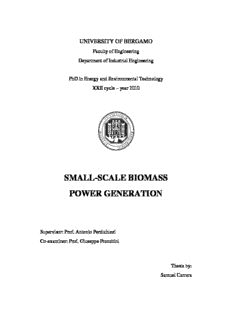
small-scale biomass power generation PDF
Preview small-scale biomass power generation
UNIVERSITY OF BERGAMO Faculty of Engineering Department of Industrial Engineering PhD in Energy and Environmental Technology XXII cycle – year 2010 SMALL-SCALE BIOMASS POWER GENERATION Supervisor: Prof. Antonio Perdichizzi Co-examiner: Prof. Giuseppe Franchini Thesis by: Samuel Carrara Fatti non foste a viver come bruti, ma per seguir virtute e canoscenza. (Ye were not made to live like unto brutes, But for pursuit of virtue and of knowledge.) Dante Alighieri, The Divine Comedy, Inferno, Canto XXVI, lines 119-120 Abstract In recent years considerable attention has been paid to power generation from biomass, especially in small scale plants. Several plant configurations have been proposed and investigated, but so far, definitely preferable technological solutions have not been found yet. Moreover, a comparison of their performances is often difficult, due to the fact that working assumptions are not always consistent. The aim of the present work is to provide a full overview on small scale technologies regarding biomass exploitation (particularly woody one) for power generation, in order to define the most interesting solutions from a thermodynamic and economic point of view. Existing configurations or those which are expected to be potentially available on the market in the near future have been considered. Three plant sizes have been focused: 100 kW , 1 MW and 5 MW . Internal combustion engines (ICE), (micro) gas turbines el el el (mGT/GT), both internally and externally fired, and organic Rankine cycles (ORC) have been taken into account as power plants, while direct combustion and gasification have been considered for biomass. Simulations show that the externally fired gas turbine is the most promising technology at small scale (100 kW ), if a high temperature heat exchanger is available. A gasifier el coupled with an internal combustion engine is instead preferable at larger scales (1 MW and 5 MW ). el el An also proposed sensitivity analysis concerning moisture effects shows that biomass drying with flue gas is generally disadvantageous, even if sometimes (e.g. in gasifiers) necessary, because of the dryer cost. Acknowledgements After twenty-one years, my career as a student comes to an end with this thesis. In this moment I am thinking back to the people who accompanied me and to the episodes which occurred during these years: if I had to list all of them, I should probably write another book! However, someone once said that one book per time is enough, when it is not too much, then I will just greet and thank the people who were important during the PhD period and who helped me reach this further goal, starting from the university teaching staff who bore me again after my bachelor and master degrees. My dutiful thanks go to my Supervisor, Prof. Antonio Perdichizzi, for giving me once more the chance to collaborate with his research group and to develop this thesis under his guidance. I am very grateful to my Co-examiner, Prof. Giuseppe Franchini, for having me always granted a huge support: working with him has always been stimulating and pleasant. My thanks also go to Prof. Gianpietro Cossali, Prof. Giovanna Barigozzi and all the other professors who have always proven to be very helpful. I warmly hug all PhD and post-doc students whom I met in these years and who shared with me the serenity of the positive moments and discouragement of the difficult ones: I will miss the PhD office and the lunches at Gattopardo’s or Centrale’s! Naturally, I cannot but thank my parents, my brother, my grand-mother and all my other relatives, who helped me be what I am now. My loving thanks go Laura and her family: the gratitude that I fell towards them cannot be described in few words; my thanks also to Mrs. Schroeder for the appreciated support. Obviously I want to thank all friends of mine and all the other people who have been close to me and that cannot be cited here. Finally, my special thanks to the ones who, without being seen, help me every single day from up above. Table of contents Table of contents Table of contents...................................................................................................I Nomenclature...................................................................................................VII List of Figures....................................................................................................XI List of Tables.................................................................................................XVII Introduction.........................................................................................................1 Chapter 1 Biomass and technologies for its exploitation...................................................5 1.1 Introduction..........................................................................................................5 1.2 The energy issue and biomass role.......................................................................5 1.2.1 Italian situation and perspectives...............................................................11 1.2.1.1 Primary energy..............................................................................11 1.2.1.2 Electric energy...............................................................................13 1.3 Biomass and its chains........................................................................................14 1.3.1 The resource..............................................................................................14 1.3.2 Photosynthesis...........................................................................................17 1.3.3 Conversion principles and chains..............................................................19 1.3.3.1 Alcoholic fermentation..................................................................21 1.3.3.2 Vegetable oil esterification............................................................22 1.3.3.3 Anaerobic digestion.......................................................................22 1.3.3.4 Aerobic digestion...........................................................................23 I Table of contents 1.4 Woody biomass properties.................................................................................23 1.4.1 Chemical properties...................................................................................24 1.4.2 Physical properties.....................................................................................26 1.4.3 Energy properties.......................................................................................27 1.5 Woody biomass conversion technologies..........................................................29 1.5.1 Combustion................................................................................................30 1.5.1.1 Combustion devices.......................................................................32 1.5.1.2 Emissions.......................................................................................34 1.5.2 Pyrolysis....................................................................................................36 1.5.3 Gasification................................................................................................36 1.5.3.1 Gasifiers.........................................................................................40 1.5.3.2 Syngas treatment...........................................................................49 Chapter 2 Small-scale power plants...................................................................................55 2.1 Introduction........................................................................................................55 2.2 Small-scale power generation and CHP.............................................................56 2.3 Internal combustion engines...............................................................................59 2.4 Gas turbines........................................................................................................64 2.4.1 Micro gas turbines.....................................................................................68 2.4.2 Comparison among ICE, GT and mGT.....................................................75 2.4.3 Externally fired gas turbines......................................................................76 2.5 Organic Rankine cycles......................................................................................80 2.6 Other technologies..............................................................................................86 2.6.1 Stirling engines..........................................................................................86 2.6.2 Steam engines............................................................................................88 2.6.3 Fuel cells....................................................................................................88 Chapter 3 Working hypotheses and preliminary analysis...............................................93 3.1 Introduction........................................................................................................93 3.2 Thermoflex™.....................................................................................................94 II
Description: